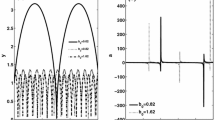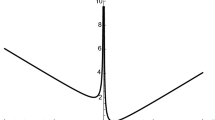Abstract
This article describes new aspects of hysteresis dynamics which have been uncovered through computer experiments. There are several motivations to be interested in fast-slow dynamics. For instance, many physiological or biological systems display different time scales. The bursting oscillations which can be observed in neurons, β-cells of the pancreas and population dynamics are essentially studied via bifurcation theory and analysis of fast-slow systems (Keener and Sneyd, 1998; Rinzel, 1987). Hysteresis is a possible mechanism to generate bursting oscillations. A first part of this article presents the computer techniques (the dotted-phase portrait, the bifurcation of the fast dynamics and the wave form) we have used to represent several patterns specific to hysteresis dynamics. This framework yields a natural generalization to the notion of bursting oscillations where, for instance, the active phase is chaotic and alternates with a quiescent phase. In a second part of the article, we emphasize the evolution to chaos which is often associated with bursting oscillations on the specific example of the Hindmarsh–Rose system. This evolution to chaos has already been studied with classical tools of dynamical systems but we give here numerical evidence on hysteresis dynamics and on some aspects of the wave form. The analytical proofs will be given elsewhere.
Similar content being viewed by others
References
Arvanitaki, A. (1939). Recherches sur la réponse oscillatoire locale de l'axone géant de Sepia. Archive International Physiology 49: 209–256.
Atwater, I., C.M. Dawson, G. Eddlestone and E. Rojas (1980). The nature of the oscillatory behavior in electrical activity from pancreatic β-cell. Journal of Hormonal Metabolic Research 10 (suppl.): 100–107.
Decroly, O. and A. Goldbeter (1987). From simple to complex oscillatory behaviour Analysys of bursting in a multiply regulated system Journal of Theoretical Biology 124: 219–250.
Faure, P. and H. Korn (2001). Is there chaos in the brain? I. Concepts of nonlinear dynamics and methods of investigation. Comptes Rendus Biologie 324: 773–793.
Goldbeter, A. (1990). Rythmes et Chaos dans les systèmes biochimiques et cellulaires, Masson, Paris.
Hindmarsh, J.L. and R.M. Rose (1984). A model of neuronal bursting using three coupled first order differential equations. Nature 196: 162–164.
Keener, J. and J. Sneyd (1998). Mathematical Physiology. Springer Verlag, New York.
Kuznetsov, A. Yu., O. De Feo and S. Rinaldi (2001). Belyakov homoclinic bifurcations in a tritrophic food chain model. SIAM Journal of Applied Mathematics 62(2): 462–487.
Martiel, J.L. and A. Goldbeter (1987). Origin of bursting and birhythmicity in a model for cyclic AMP oscillations in Dictyostellium cells. Lecture Notes in Biomathematics 71: 244–255.
Muratori, S. and S. Rinaldi (1992). Low and high-frequency oscillations in three dimensional food chain systems. SIAM Journal of Applied Mathematics 52: 1688–1706.
Murray, J. (2002). Mathematical Biology. Springer Verlag, New-York.
Rinzel, J. (1987). A formal classification of bursting mechanisms in excitable systems, in Mathematical Topics in Population Biology, Morphogenesis and Neurosciences, Lecture Notes in Biomathematics, vol. 71: Ed. Teramoto, E. and M. Yamaguti (Springer Verlag, Berlin).
Rinzel, J. and Y.S. Lee (1987). Dissection of a model for neuronal parabolic bursting. Journal of Mathematical Biology, 25: 653–675.
Strogatz, S. (1994). Nonlinear dynamics and chaos: With applications to physics, biology, chemistry and engineering. Reading, MA: Perseus Books.
Terman, D. (1991). Chaotic spikes arising from a model for bursting in excitable membranes, SIAM Journal of Applied Mathematics 51: 1418–1450.
Thom, R. (1988). Esquisse d'une Sémiophysique, InterEditions, Paris.
Wang, X.-J. (1993). Genesis of bursting oscillations in the Hindmarsh–Rose model and homoclinicity to a chaotic saddle. Physica D 62: 263–274.
Author information
Authors and Affiliations
Rights and permissions
About this article
Cite this article
Françoise, JP., Piquet, C. Hysteresis Dynamics, Bursting Oscillations and Evolution to Chaotic Regimes. Acta Biotheor 53, 381–392 (2005). https://doi.org/10.1007/s10441-005-4892-1
Received:
Accepted:
Issue Date:
DOI: https://doi.org/10.1007/s10441-005-4892-1




